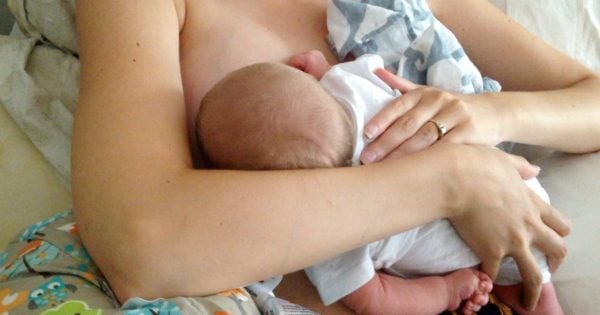Talk to new mothers about breastfeeding, and there’s one message sure to come through: it’s painful and it’s difficult.
Dr Pam Douglas, a researcher at the University of Queensland, says women tell her that the pain they suffer while breastfeeding is worse than labour.
“It’s just heartbreaking because women want to breastfeed,” she tells Mamamia. “I get so cross when people talk about women not persevering because I see it every day in the clinic. It’s a heroism. Women just go on and on and on through the most extraordinary pain, trying to breastfeed their baby.”
But breastfeeding is not meant to be painful or difficult. So what’s going so wrong for so many women?
Dr Douglas has spent years researching just that. She believes the fault lies in the way women are being advised when it comes to latching and positioning – or, as she calls it, “fit and hold”.
“It’s actually a health system problem,” she says. “We are not adequately helping women. We don’t know how to pick up that there’s a fit-and-hold problem.”
She also believes that a lot of the time when babies won’t latch, or they pull off the breast, arch their back and cry, the problem is with the fit and hold.

Top Comments
Initially, for me breastfeeding was absolutely excruciating. My nipples bled and I think I walked around topless for the first 3 days because they were just on fire but after about a week or so they adjusted and the pain went away and it was smooth sailing thereafter.
I would choose a day of labour over a day of breastfeeding, hands down. Worst pain in my life. It felt like little knives were stabbing into my nipples, while my body shook and broke out in sweat every time. Every midwife I asked said my daughter was attacking perfectly and that there shouldn't be an issue.
I hope it's not the same next time around, but as no one was able to identify a problem, not sure what I should do differently!
That sounds so horrible:( I found breast feeding so painful and hard with my first to begin with but was super fortunate to have a family friend who was also a lactation consultant who was a world of advice and support for me.
My best advice would be to find yourself a good lactation consultant, have nipple shields and hydrogel pads on standby if it gets painful (cumbersome but a lifesaver when you need them) and get your baby checked and checked again for tongue tie/ lip tie (super common issue with little babies that can cause a lot of pain and discomfort for new mums despite the latch looking perfect)